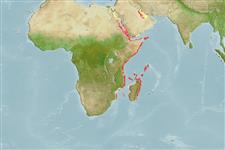Common names from other countries
Classification / Names / Names
Noms communs | Synonymes | Catalog of Fishes (gen., sp.) | ITIS | CoL | WoRMS
Environment: milieu / climate zone / depth range / distribution range
Écologie
; profondeur 0 - 30 m (Ref. 847). Tropical; 30°N - 25°S, 32°E - 55°E (Ref. 847)
Distribution
Pays | Zones FAO | Écosystèmes | Occurrences | Introductions
Western Indian Ocean: Red Sea, Gulf of Aden, Somalia Coastal Current and Madagascar.
Length at first maturity / Taille / Poids / Âge
Maturity: Lm ? range ? - ? cm Max length : 4.0 cm BRW mâle / non sexé; (Ref. 847)
Description synthétique
Morphologie
Colonies are usually clumps of short knobby branches up to 40 mm thick with blunt ends. Corallites are crowded and immersed to conical with hoods facing different directions. Uniform cream in color.
Life cycle and mating behavior
Maturité | Reproduction | Frai | Œufs | Fécondité | Larves
Members of the class Anthozoa are either gonochoric or hermaphroditic. Mature gametes are shed into the coelenteron and spawned through the mouth. Life cycle: The zygote develops into a planktonic planula larva. Metamorphosis begins with early morphogenesis of tentacles, septa and pharynx before larval settlement on the aboral end.
Veron, J.E.N. 2000. (Ref. 847)
Statut dans la liste rouge de l'IUCN (Ref. 130435)
statut CITES (Ref. 108899)
Not Evaluated
Utilisations par l'homme
| FishSource |
Outils
Plus d'informations
Taille/ÂgeCroissanceLongueur-poidsLongueur-longueurMorphologieLarvesAbondance
Sources Internet
Estimates based on models
Preferred temperature
(Ref.
115969): 25.6 - 29.2, mean 27.5 (based on 421 cells).
Vulnérabilité
Low vulnerability (10 of 100).
Catégorie de prix
Unknown.
